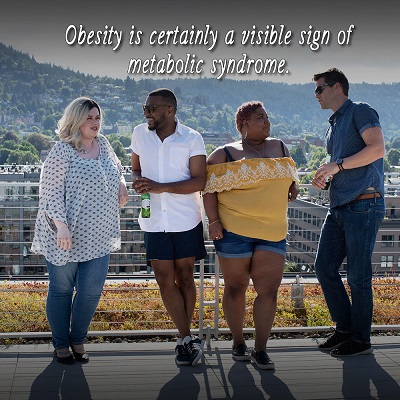 We know of many visible signs for certain health conditions. For example, it’s easy to spot someone with a cold or the flu. However, it’s not every day you hear someone say, ‘Oh look, that person has metabolic syndrome.’
We know of many visible signs for certain health conditions. For example, it’s easy to spot someone with a cold or the flu. However, it’s not every day you hear someone say, ‘Oh look, that person has metabolic syndrome.’
Rarely do people get ‘health-alarmed’ by their increasing weight and enlarged waistline and abdomen, either. You don’t hear anyone saying, ‘Oh no! I could get metabolic syndrome if I am not careful!’ You’re more likely to hear them complain about their clothes getting too tight or their appearance.
Many of us think that being fat is just that, being fat. However, being fat is not just that. There are serious health consequences that can develop, including metabolic syndrome. Obesity is certainly a visible sign of metabolic syndrome.
Abdominal obesity is now considered to be a real health hazard, especially because it is one of the main conditions of metabolic syndrome (MetS).
The sooner each of the metabolic syndrome symptoms, or risk factors, are detected and addressed, the greater chance you have of living healthier and longer.
Visible Signs of Metabolic Syndrome
This is tricky as quite often, the signs of metabolic syndrome are not visible. The co-occurrence of at least three or more of the following conditions may give the diagnosis of metabolic syndrome. It takes a medical doctor to go through a series of physical examinations and tests for a correct diagnosis; however, if you are looking for visible signs, we are going to try and address each condition.
Abdominal Obesity
This one is an easy one, as it is certainly visible! Abdominal obesity is the only physical and visible sign of metabolic syndrome. Do not underestimate the possible health consequences that usually come along with excess body fat, particularly a large waistline and enlarged abdomen.
As a rule of thumb, women with a waist circumference of 35 inches or more, and men with a waist circumference of 40 inches or more need to be more vigilant of their health and weight.
Generally, when you put on more weight than you should, and you begin to develop an apple or pear-shaped abdomen, that’s an alarm for you to start losing excess pounds before anything more serious develops.
High Triglyceride Levels
Triglycerides are a type of fat that’s within the blood created by the body. It’s all part of your cholesterol count too. The more overweight a person is, the higher their triglyceride levels become. This is bad news for your health because it can lead to metabolic syndrome. A triglyceride level of 150 mg/dL and above, together with abdominal obesity, poses serious health risks.
High triglyceride levels are a sign of metabolic syndrome. However, there are no visible signs of having high triglyceride levels.
Low HDL (Good) Cholesterol Levels
Cholesterol is not all bad; we actually need adequate HDL cholesterol for health. Unfortunately, most people who have never had to deal with their cholesterol assume that it’s all bad, so don’t do anything about looking after their good cholesterol.
To stay healthy, you’ll need high, healthy levels of HDL cholesterol to remove the bad LDL cholesterol from your arteries.
Therefore, if you have low levels of HDL cholesterol, it is a sign that you are at a higher risk of developing metabolic syndrome, especially if you show any of the other signs or symptoms we are discussing now.
Again, there are no visible signs to detect insufficient HDL cholesterol. However, you can start eating the right foods to increase your HDL cholesterol, such as avocado, fatty fish and nuts.
High Blood Sugar
The presence of sufficient insulin hormones in the body is necessary for regulating blood sugar levels. However, in cases of insulin resistance, the cells do not respond the way they should, which causes persistently high levels of blood sugar.
If the pancreas continually produces insulin to attempt to regulate and manage blood sugar, then this is another sign of the presence of metabolic syndrome, especially if it occurs simultaneously with the other risk factors.
People exhibiting clinical features of insulin resistance include darkening of the skin in certain areas and the presence of skin tags. These are possible physical signs to look for.
High Blood Pressure
Blood pressure levels higher than 130/85 become another sign or risk factor of metabolic syndrome. High blood pressure is also a serious health risk on its own.
High blood pressure increases the risk of stroke and heart attack. It is very important to manage healthy blood pressure levels by dramatically changing your lifestyle by quitting smoking, managing stress levels, and maintaining a healthy diet.
The visible signs are hard to detect, as quite often, there aren’t any. However, many people do have headaches or feel dizzy and light-headed.
If you are trying to determine whether you have metabolic syndrome by viewing what the possible physical symptoms are, stop looking or trying to self-diagnose. You can’t and shouldn’t. Please visit your doctor to determine the answer.






